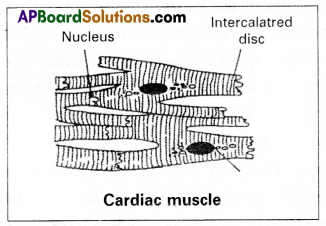Andhra Pradesh BIEAP AP Inter 1st Year Zoology Study Material Lesson 2 Structural Organisation in Animals Textbook Questions and Answers.
AP Inter 1st Year Zoology Study Material Lesson 2 Structural Organisation in Animals
Very Short Answer Type Questions
Question 1.
The body of sponges does not possess a tissue level of organisation, though it is made up of thousands of cells. Comment on it.
Answer:
Even though the sponge’s body is made up of thousands of cells, they exhibit a cellular grade of organization, due to the absence of sensory and nerve cells spongs do not possess a tissue level of organisation.
Question 2.
What is the tissue level of organisation among animals? Which metazoans exhibit this organisation?
Answer:
The tissue level of organisation is the lowest level of organisation among the eumetazoans, exhibited by diploblastic animals like cnidarians.
Question 3.
Animals exhibiting which level of organisation lead the relatively more efficient way of life when compared to those of the other levels of organisation? Why?
Answer:
Animals exhibit an organ-system level of organisation of the animals and are exhibited by the triploblastic animals.
Organ level of organisation is a further advancement over the tissue level in the evolution of levels of organisation.
Question 4.
What is monaxial heteropolar symmetry? Name the group of animals in which it is the principal symmetry.
Answer:
Monaxial heteropolar symmetry: When any plane passing through the central axis of the body divides an organism into two identical parts is called Monaxial heteropolar symmetry or radial symmetry. It is the principal symmetry of diploblastic animals such as Cnidarians and ctenophores.
![]()
Question 5.
Radial symmetry is an advantage to sessile or slow-moving organisms. Justify this statement.
Answer:
Animals showing radial symmetry live in water and they can respond equally to stimuli that arrive from all directions. Thus, radial symmetry is an advantage to sessile or slow-moving animals.
Question 6.
What is cephalization? How is it useful to its possessors?
Answer:
Cephalization: Concentration of nerve (Brain) and sensory cells at the anterior end of the body is called Cephalization. As a result of cephalization, these animals can sense the new environment and are more efficient than the other animals in seeking food, locating mates, and avoiding or escaping from predators.
Question 7.
Mention the animals that exhibited a ‘tube-within-a-tube’ organisation for the first time? Name their body cavity.
Answer:
Cnidarians and some flat warms are the first animals to exhibit a ‘tube-within-a-tube’ organisation. The body cavity is pseudocolor.
Question 8.
Why is the true coelom considered a secondary body cavity?
Answer:
During the embryonic development of the coelomates, the blastocoel is replaced by a true coelom derived from the mesoderm. So, the true coelom is also called ‘the secondary body cavity.
Question 9.
What are retroperitoneal organs?
Answer:
Certain organs such as the kidneys of the vertebrates are covered by the parietal peritoneum only on their ventral side. Such a peritoneum is called the ‘retroperitoneum’ and the organs lined by it are called ‘retroperitoneal organs.
Question 10.
If the mesentoblast cell is removed in the early embryonic development of protostomes what would be the fate of such animals?
Answer:
In the protostomes, the mesentoblast cell of the early embryo divides to form mesodermal blacks between the ectoderm and the endoderm and replaces the blastocoel. The split that appears in each mesodermal black leads to the formation of Schizocoelom. If the mesentoblast cell is removed in the early embryonic development of protostomes it will cause no ceolome in their animals.
Question 11.
What is enterocoelom? Name the enterocoelomate phyla in the animal kingdom.
Answer:
Animals in which the body cavity is formed from the mesodermal pouches of archenteron are called ‘enterocoelomates’.
Echinoderms, hemichordates, and chordates are enterocoelomates.
Question 12.
Stratified epithelial cells have a limited role in secretion. Justify their role in our skin.
Answer:
The main function of stratified epithelial cells is to provide protection against chemicals and mechanical stress. Hence the stratified epithelial cells have a limited role in secretion.
![]()
Question 13.
Distinguish between exocrine and endocrine glands with examples.
Answer:
Exocrine glands are provided with ducts. Secrete mucus, saliva, earwax, oil, milk, digestive enzymes, and other cell products.
Endocrine glands are ductless and their products are hormones that are not sent out via ducts but are carried to the target organs by blood.
Ex: Pituitary gland.
Question 14.
Distinguish between holocrine and apocrine glands.
Answer:
Apocrine glands in which the apical part of the gland cell in pinched off along with the secretory product.
Ex: Mammary glands
Holocrine glands, in which the entire cell disintegrates to discharge the contents.
Ex: Sebaceous glands
Question 15.
Mention any two substances secreted by mast cells and their functions.
Answer:
Mast cells secrete heparin – an anticoagulant, histamine, bradykinin – vasodilators, and serotonin – vasoconstrictor. Vasodilators cause inflammation in response to injury and infection.
Question 16.
Distinguish between a tendon and a ligament.
Answer:
Tendons are the collagen fibrous tissue of dense regular connective tissue which attaches the skeletal muscles to bones.
Ligaments are also the collagen fibers tissue of dense regular connective tissue which attach bones to other bones.
Question 17.
Distinguish between brown fat and white fat.
Answer:
White fat: It is the predominant type in adults, the adipocyte has a single large lipid droplet. White fat is metabolically not active.
Brown fat: It is found in fetuses and infants. Adipocyte of Brown fat has several small ‘lipid droplets’ and are metabolically active and generates heat to maintain body temperature required by infants.
Question 18.
What is the strongest cartilage? In which regions of the human body, do you find it?
Answer:
The fibrous cartilage is the strongest of all types of cartilage. It occurs in the intervertebral discs and pubic symphysis of the pelvis.
Question 19.
Distinguish between osteoblasts and osteoclasts.
Answer:
Osteoblasts are immature bone cells that secrete the organic components of the matrix and also play an important role in the mineralization of bone and become Osteocytes. Osteoclasts are phagocytic cells involved in the resorption of bone.
![]()
Question 20.
Define Osteon.
Answer:
In compact bone structure, a Haversian canal and the surrounding lamellae and lacunae are collectively called a Haversian system or Osteon.
Question 21.
What are Volkmann’s canals? What is their role?
Answer:
In compact bone structure, the Haversian canals communicate with one another, with the periosteum and also with the marrow cavity by transverse or oblique canals called Volkmann’s canals.
Question 22.
What is a Sesamoid bone? Give an example.
Answer:
Sesamoid bones are formed by ossification in tendons.
Eg: Patella (Knee cap) and Pisiform bone of the wrist of a mammal.
Question 23.
What is lymph? How does it differ from plasma?
Answer:
Lymph is a colourless fluid. It lacks RBC, platelets, and large plasma proteins, but has more number of leucocytes. It is chiefly composed of plasma and lymphocytes.
Question 24.
What is the hematocrit value?
Answer:
The percentage of the total volume occupied by RBCs in the blood is called the hematocrit value.
Question 25.
What are intercalated discs? What is their significance?
Answer:
The dark lines across cardiac muscle are called intercalated discs (IDS). These discs are highly characteristic of the cardie muscle.
Question 26.
“Cardiac muscle is highly resistant to fatigue”. Justify.
Answer:
The cardiac muscle is highly resistant to fatigue because it has numerous acrosomes, many molecules of myoglobin (Oxygen storing pigment), and a copious supply of blood which facilitate continuous aerobic respiration. The muscles are immune to fatigue and work tirelessly from the embryonic state until death.
Question 27.
Distinguish between ‘nucleus’ and ‘ganglion’ with respect to the nervous system.
Answer:
A group of cell bodies in the Central Nervous System is called a ‘nucleus’, and in the Peripheral Nervous System, it is called a ‘ganglion’.
Question 28.
Distinguish between tracts and nerves with respect to the nervous system.
Answer:
Groups of axons (nerve fibers) in the central nervous system (CNS) are called tracts’ and in the peripheral nervous system (PNS) they are called ‘nerves’.
Question 29.
Name the glial cells that form the myelin sheath around the axons of the central nervous system and peripheral nervous system respectively.
Answer:
In the central nervous system, the glial cells are called ‘Oligodendrocytes’, in the peripheral nervous system, the glial cells are called Schwann cells.
![]()
Question 30.
Distinguish between white matter and Greymatter of ‘CNS’.
Answer:
Myelinated nerve fibers occur in the white matter of the CNS, and in most peripheral nerves, and Non-myelinated axons are commonly found in the grey matter of the CNS and autonomous nervous system.
Question 31.
What are microglia and what is their origin add a note on their function.
Answer:
Microglial cells are the Neurogila (supporting cells) of cells of CNS which are phagocytic cells, of mesodermal origin.
Question 32.
What are pseudounipolar neurons? Where do you find them?
Answer:
In a unipolar neuron, the soma or cyton is found in the dorsal root ganglion they are called pseudounipolar neurons. These are found in spinal nerves.
Short Answer Type Questions
Question 1.
Describe the four different levels of organization in metazoans.
Answer:
The levels of organisation in metazoans are as follows:
1. Cellular level of organisation: It is the lowest level of organisaiton among the metazoans and ‘ is exhibited by the sponges. Different types of cells are functionally isolated due to the absence of sensory and nerve cells. There is no uniformity of labor among the cells and they don’t form tissues.
2. Tissue level of organisation: This is the lowest level of organisation among the eumetazoans, exhibited by diploblastic animals like the cnidarians. In these animals, the cells which perform the same function are arranged into tissues due to the presence of nerve cells and sensory cells.
3. Organ level of organisation: An aggregation of different kinds of tissues that are specialized for a particular function is called an organ. Organ level of organisation is a further advancement over the tissue level in the evolution of levels of organisation. It is the first time appeared in the members of platyhelminths.
4. Organ-system level: It is the highest level of organisation among the animals and is exhibited by triploblastic animals such as the flatworms, nematodes, annelids, arthropods, molluscs, echinodermates, and chordates. High specilized sensory and nerve cells bring about a higher level of coordination and integration among the various organ systems to lead an efficient way of life.
Question 2.
In which group of bilaterians do you find solid bauplan? Why is it called so?
Answer:
The bilaterian’s body plan is the solid bauplan when only one plane that passes through the identical axis divides an organism into two identical parts, it is called bilateral symmetry. It is the principal type of symmetry in triploblastic animals.
Bilaterally symmetrical animals are more efficient than the other animals in seeking food locating mates and in avoiding or escaping from predators, because of cephalization. As a result of cephalization, bilaterally symmetrical animals can sense the new environment into which they enter and respond more efficiently and quickly.
Question 3.
Mention the advantages of coelom over pseudocolor.
Answer:
Advantages of coelom over pseudocoelom:
1. Visceral organs of eucoelomates are muscular (because of their association with mesoderm) and so they can contract and relax freely independent of the muscular movements of the body wall in the coelomic space, e.g.: peristaltic movements of the alimentary canal.
2. Gametes are released into the coelom in some invertebrates (which do not have glnoducts) and in the female vertebrates.
3. Coelomic fluid receives excretory products and stores them temporarily before their elimination.
4. In the eucoelomates, the mesoderm comes into contact with the endoderm of the alimentary canal, and it causes ‘regional specialization of the gut, such as the development of gizzard, stomach, etc., This is referred to as ‘primary induction’. In the case of the pseudocoelomates, due to the absence of such a contract between the gut and the mesoderm, the wall of the gut does not show complex and highly specialized organs.
![]()
Question 4.
Describe the formation of schizocoelom and enterocoelom.
Answer:
Schizocoelom: During embryonic development, a specialized cell called 4d blastomere is formed. The cells formed from these cells divide and redivide and develop blocks of mesoderm in blastocoel. The blocks fuse and form the mesodermal band which later on splits to form the Schizocoelom. This type of coelom is present in Annelida, Arthropoda, and Mollusca.
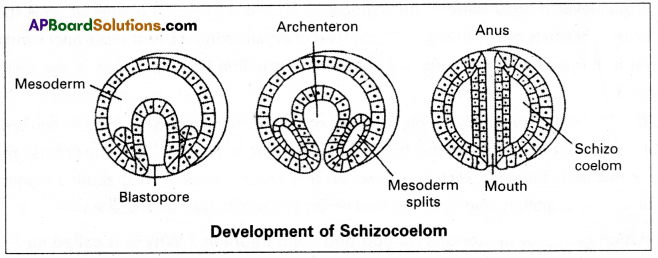
Enterocoelomates: Animals in which the body cavity is formed from the mesodermal pouches of archenteron are called enterocoelomates. Echinoderms, hemichordates, and chordates are enterocoelomates. In these animals, mesodermal ouches that evaginate from the wall of the archenteron into the blastocoel are fused with one another to form the enterocoelom. All the enterocoelomates are deuterostomes and they show radial and indeterminate cleavage.
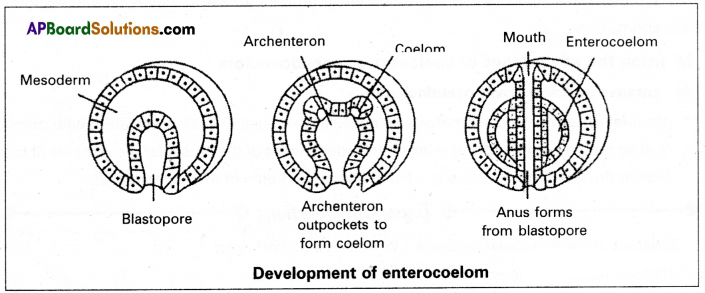
Question 5.
Describe briefly the three types of intercellular junctions of epithelial tissues.
Answer:
The specialized ‘junctions’ provide both structural and functional links between the individual cells of an epithelium. They show different types of junctions so as to serve the specific needs of that tissue. They are
(A) Tight junctions: These junctions between epithelial cells prevent ‘leakages’ of body fluids. For example, they prevent leakages of water into the surrounding cells in our sweat glands. The plasma membranes of adjacent cells are tightly pressed against each other and are bound together by specific proteins.
(B) Desmosomes: Muscle cells are provided with “desmosomes” (anchoring junctions) which act as ‘rivets’ binding the cells together into strong sheets. Intermediate filaments made of protein ‘keratin’ anchor desmosomes in the cytoplasm.
(C) Gap junctions: They provide continuous cytoplasmic channels between adjacent cells. Various types of ions, sugar molecules amino acids, etc. can pass from a cell to an adjacent cell through ‘gap junctions. They occur in many types of tissues including the ‘cardiac muscles’ where they allow rapid conduction of impulses or depolarization.
Question 6.
Give an account of glandular epithelium.
Answer:
Glandular epithelium: Some of the columnar or cuboidal cells that get specialised for the production of certain secretions, form glandular epithelium. The glands are of two types.
Unicellular glands: Consisting of isolated glandular cells such as goblet cells of the gut.
Multicellular glands: Consisting of clusters of cells such as salivary glands. On the basis of the mode of pouring of their secretions, glands are divided into two types namely exocrine and endocrine glands.
Exocrine glands: These glands provided with ducts secrete mucus, saliva, earwax, oil, milk, digestive enzymes, etc.
Endocrine glands: These glands are ductless and their products are hormones, which are carried to the target organs by blood.
Based on the mode of secretion, Exocrine glands are further divided into three types.
1. Merocrine glands: Which release the secretory granules without the loss of other cellular material.
Ex: Pancreas
2. Apocrineglands: The apical part of the cell is pinched off along with the secretory product.
Ex: Mammary glands
3. Holocrine glands: The entire cell disintegrates to discharge the contents.
Ex: Sebaceous gland
Question 7.
Give a brief account of the cells of areolar tissue.
Answer:
Areolar tissue: It is one of the most widely distributed connective tissue in the body. It forms the packing tissue in almost all organs. Areolar tissue forms the subcutaneous layer of the skin. It has cells and fibres. Cells of the areolar tissue are fibroblasts, mast cells, macrophages, adipocytes, and plasma cells.
1. Fibroblasts are the most common cells which secrete fibres. The inactive cells are called fibrocytes.
2. Mast cells secrete heparin (an anticoagulant), histamine, bradykinin (vasodilators), and serotonin vasoconstrictor). Vasodilators cause inflammation in response to injury and infection.
3. Macrophages are amoeboid cells, Phagocytic in function, and act as internal scavengers. They are derived from the monocytes of blood. Tissue-fixed macrophages’ are called histiocytes and others are ‘wandering macrophages’.
4. Plasma cells are derived from the B-lymphocytes and produce antibodies.
5. Adipocytes are specialized cells for the storage of fats.

Question 8.
Describe the three types of cartilage.
Answer:
Cartilage is a solid, but semi-rigid (flexible) connective tissue. Cartilage is of three types, which differ from each other chiefly in the composition of the matrix.
Cartilage is a solid, but semi-rigid (flexible) connective tissue It resists compression. Matrix is firm but somewhat pliable. It has collagen fibres, elastic fibres (only in the elastic cartilage), and matrix-secreting cells called chondroblasts. These cells are enclosed in fluid-filled spaces called lacunae. Chocolates are the inactive cells of cartilage. Cartilage is surrounded by a fibrous connective tissue sheath called perichondrium. Cartilage is of three types, which differ from each other chiefly in the composition of the matrix.
1. Hyaline cartilage: It is bluish-white, translucent, and glass-like cartilage. Matrix is homogeneous and shows delicate collagen fibres. It is the weakest and the most common type of cartilage. It is found in the walls of the nose, larynx, trachea, and bronchi.
2. Elastic cartilage: It is yellowish due to elastic fibres. Matrix has an abundance of yellow elastic fibres in addition to collagen fibres. It provides strength and elasticity. Perichondrium is present. It is found in the pinnae of the external ears, Eustachian tubes, and epiglottis.
3. Fibrous cartilage: Matrix has bundles of collagen fibres. The perichondrium is absent. It is the strongest of all types of cartilage. It occurs in the Intervertebral discs and pubic symphysis of the pelvis.
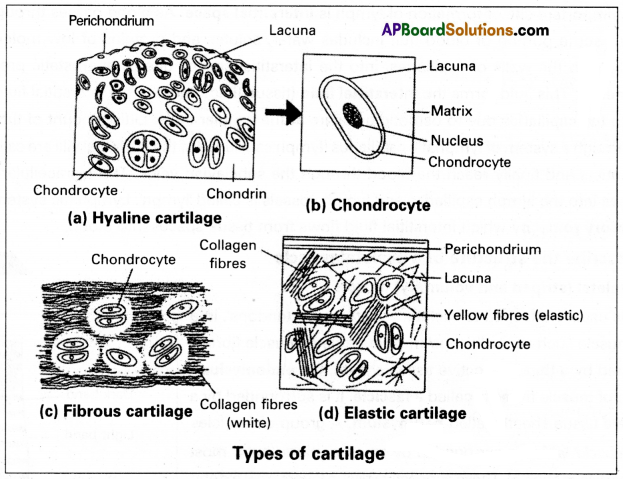
Question 9.
Explain the Haversian system.
Answer:
The compact bone consists of several structural units called Osteons or Haversian systems arranged around and parallel to the bone marrow cavities.
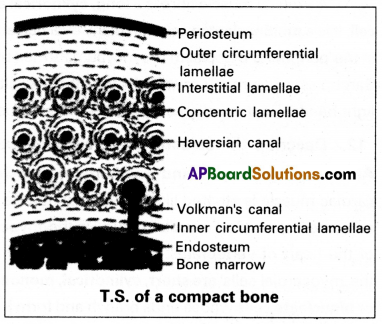
The Haversian system consists of a Haversian canal that runs parallel to the marrow cavity. It contains an artery, a vein, and a lymphatic vessel. The Haversian canal is surrounded by concentric lamellae. Small fluid-filled spaces called ‘lacunae’ provided with minute canaliculi lie in between the lamellae. Canaliculi connect the lacunae with one another and with the Haversian canal.
Each lacuna encloses one osteocyte (an inactive form of osteoblast). The cytoplasmic processes of osteocytes extend through canaliculi. A Haversian canal and the surrounding lamellae and lacunae are collectively called a Haversian system or osteon. The Haversian canals communicate with one another, with the perio¬steum and also with the marrow cavity by transverse or oblique canals called Volkmann’s canals. Nutrients and gases diffuse from the vascular supply of Haversian canals.
![]()
Question 10.
Write short notes on lymph.
Answer:
Lymph: Lymph is a colourless fluid. It lacks RBC, platelets, and large plasma proteins, but has more number of leucocytes. It is chiefly composed of plasma and lymphocytes. When compared to the tissue fluid, it contains very small amounts of nutrients and oxygen but has abundant CO2 and other metabolites.
The most important site of the formation of lymph is the interstitial space. As blood passes through the blood capillaries, some portion of blood that includes water, solutes, and proteins of low molecular weight passer: through the walls of capillaries, into the interstitial spaces due to hydrostatic pressure at the arteriolar ends. This fluid forms the interstitial fluid (tissue fluid). Most of the interstitial fluid is returned directly to the capillaries due to osmotic pressure at the venular ends.
A little amount of this tissue fluid passes through a system of lymphatic capillaries (lymph capillaries of the intestinal villi are called ‘lacteals’), vessels, and ducts and finally, reaches the blood through the subclavian veins. The extracellular ’tissue fluid’ that passes into the lymph capillaries and lymph vessels is called ‘lymph’. The lymphatic system represents an ‘accessory route’ by which interstitial fluid flows from tissue spaces into blood.
Question 11.
Describe the structure of a skeletal muscle.
Answer:
Skeletal (striped and voluntary) muscle:
It is usually attached to skeletal structures by ‘tendons’. In a typical muscle such as the ‘biceps’ muscle, skeletal muscle fibre is surrounded by a thin connective tissue sheath, the endomysium. A bundle of muscle fibres is called a fascicle. It is surrounded by a connective tissue sheath called perimysium. A group of fascicles forms a ‘muscle’ which is surrounded by an epimysium (outermost connective tissue sheath). These connective tissue layers may extend beyond the muscle to form a chord-like tendon or sheet-like aponeurosis.
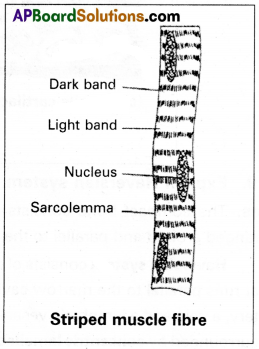
A skeletal muscle fibre is a long, cylindrical, and unbranched cell. It is a multinucleated cell with many oval nuclei characteristically in the ‘peripheral’ cytoplasm (a syncytium formed by the fusion of cells). Sarcoplasm has many myofibrils which show alternate dark and light bands. So it is called striped or striated muscle.
Question 12.
Describe the structure of a cardiac muscle.
Answer:
Cardiac (striped and involuntary) muscle: The cardiac muscle is striated like the skeletal muscle (shows sarcomeres). Cardiac muscle is found in the ‘myocardium’ of the heart of vertebrates. The cardiac muscle cells or the myocardial cells’ are short, cylindrical, mononucleate, or binucleate cells whose ends branch and form junctions with other cardiac muscle cells. Each myocardial cell is joined to adjacent myocardial cells by ‘electrical synapses’ or ‘gap junctions. They permit ‘electrical impulses to be conducted along the long axis of the cardiac muscle fibre. The dark lines across cardiac muscle are called intercalated discs (IDs). These discs are highly characteristic of the cardiac muscle.
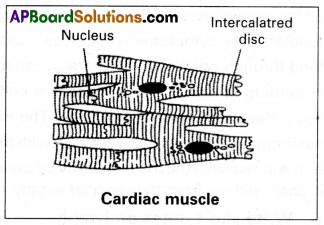
Question 13.
Give an account of the supporting cells of nervous tissue.
Answer:
Nervous tissue is of two types.
1. Nervous
2. Supporting cell or neuroglia
Neuroglia (supporting cells): These are the supporting and non-conducting cells that provide a microenvironment suitable for neuronal activity. Unlike neurons, they continue to divide throughout life. Neuroglial cells of the CNS include oligodendrocytes (that form myelin sheath as mentioned above); astrocytes (star-shaped cells) that form an interconnected network and bind neurons and capillaries (helping in providing the blood-brain barrier); ependymal cells, which are ciliated cells that line the cavities of the brain and spinal cord to bring movements in the cerebrospinal fluid; microglial cells, which are phagocytic cells, of mesodermal origin. Neuroglial cells of the peripheral nervous system include the satellite cells and Schwann cells. Satellite cells surround the cell bodies in ganglia, and Schwann cells form neurolemma around axons.
![]()
Question 14.
Describe the structure of a multipolar neuron.
Answer:
Multipolar neurons have one axon and two or more dendrites. Most neurons in our body are multipolar neurons.
A neuron usually consists of a cell body with one too many dendrites and a single axon.
Neurons: Neurons are the ‘functional units of nervous tissue. These are electrically excitable cells that receive, initiate, and conduct/transmit impulses. When a neuron is stimulated, an electric disturbance (action potential) is generated which swiftly travels along its plasma membrane. A neuron usually consists of a “cell body” with one to many dendrites and a single axon.
Cell body: It is also called perikaryon, cyton, or soma. It contains abundant granular cytoplasm and a large spherical nucleus. The cytoplasm has Nissl bodies (they represent RER, the sites of protein synthesis), neurofibrils, and lipofuscin granules.

Dendrites: Several short, branched processes that arise from the cyton are called dendrites. They also contain Nissl bodies and neurofibrils. They conduct nerve impulses towards the cell body (afferent processes).
Axon: An axon is a single, long, cylindrical process that originates from a region of the cyton called the axon hillock. The Plasmalemma of an axon is called axolemma, and the cytoplasm is called axoplasm, which contains neurofibrils. However, Nissl bodies are absent. An axon may give rise to collateral branches. Distally it branches into many fine filaments called telodendrites, (axon terminals), which end in bulb-like structures called synaptic knobs or terminal boutons. Synaptic knobs possess ‘synaptic vesicles’ containing chemicals called neurotransmitters.
Question 15.
Write short notes on (a) Platelets and (a) Synapse.
Answer:
(a) Blood platelets (Thrombocytes): These are colourless non- nucleated, round or oval biconvex discs. The number of platelets per cubic mm of blood is about 2,50,000-4,50,000. They are formed from giant megakaryocytes produced in the red bone marrow by fragmentation. The average lifespan of blood platelets is about 5 to 9 days. They secrete thromboplastin and play an important role in blood clotting. They adhere to the damaged endothelial lining of capillaries and seal minor vascular openings.

(b) Synapse: It is the place in between the two neurons or inter-neuronal or neuromuscular junctions. Nerve cells do not have direct contact with each other. There is a microscopic gap of about 200-300 A° present between the nerve cells called a synapse. The nerve cell present before synapse is called the presynaptic neuron and the behind is called the post-synaptic neuron. A neurotransmitter substance called acetylcholine is secreted in the synapse by presynaptic neurons’ telodendrites. Acetylcholine helps in the conduction of nerve impulses from one neuron to another neuron.
Long Answer Type Questions
Question 1.
What is coelom? Explain the different types of coelom with suitable examples and neat labelled diagrams.
Answer:
The body cavity, which is lined by mesoderm, is called coelom more elaborately, coelom is a fluid-filled space between the body wall and visceral organs and lined by mesodermal epithelium peritoneum. Based on the body cavity triploblastic animals can be classified into acoelomentes, pseudo-coelo mates, and coelomates.
Acoelomate bilaterians: The bilaterian animals in which the body cavity is absent are called acoelomates, e.g. Platy-helminthes (lowest bilaterians). In these animals, the mesenchyme derived from the thrid germinal layer, called mesoderm, occupies the entire blasto coel, between the ectoderm and the endoderm, so that the adults have neither the primary cavity (blasto-coelom) nor the secondary cavity (coelom). As there is no body cavity, the acoelomates exhibit a solid body plan.

Pseudocoelomate bilaterians: In some animals, the body cavity is not lined by mesodermal epithelia. Such animals are called Pseudocoelomates. They include the members of phylum Aschelminthes (Nematoda, Rotifera, and some minor phyla). During embryonic development mesoderm (mesenchyme) occupies only a part of the blastocoel adjoining the ectoderm. The unoccupied portion of the blastocoel persists as pseudocoelom.
Eucoelomate bilaterians: Coelom or ‘true coelom’ is a fluid-filled cavity, that lies between the body wall and the visceral organs and is lined by mesodermal epithelium, the peritoneum. The portion of the peritoneum that underlines the body wall is the parietal peritoneum or somatic peritoneum. The portion of the peritoneum that covers the visceral organs is the splanchnic peritoneum or visceral peritoneum. In coelomates, the visceral organs are suspended in the coelom by the peritoneum.
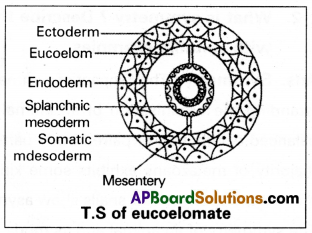
During the embryonic development of the eucoelomates, the blastocoel is replaced by the true coelom derived from the mesoderm. So, the true coelom is also called the ‘secondary body cavity. Based on the mode of formation of coelom, the eucoelomates are classified into two types:
I. Schizocoelomates: Animals in which the body cavity is formed by the ‘splitting of mesoderm’ are called schizocoelomates. Annelids, arthropods, and mollusks are schizocoelomates in the animal kingdom. All the schizocoelomates are protostomians and they show ‘holoblastic’, ‘spiral’, and ‘determinate’ cleavage. The 4d blastomere or mesentoblast cell of the early embryo divides to form mesodermal blocks between the ectoderm and the endoderm and replaces the blastocoel. The split that appears in each mesodermal block leads to the formation of Schizocoelom.
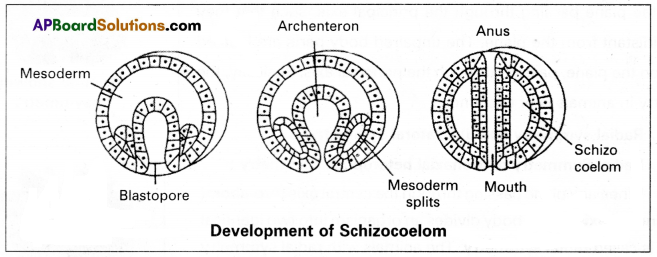
II. Enterocoelomates: Animals in which the body cavity is formed from the mesodermal pouches of archenteron are called enterocoelomates. Echinoderms, hemichordates, and chordates are the enterocoelomates. In these animals, mesodermal pouches that evaginate from the wall of the archenteron into the blastocoel are fused with one another to form the enterocoelom. All the enterocoelomates are deuterostomes and they show radial and indeterminate cleavage.
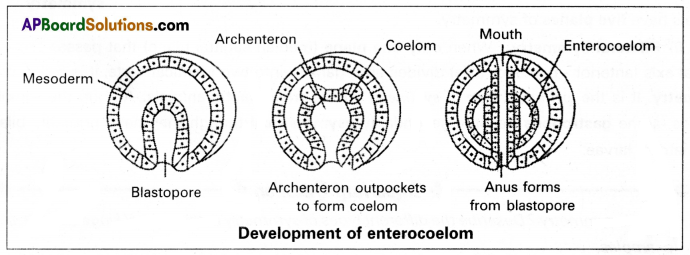
![]()
Question 2.
What is symmetry? Describe the different types of symmetry in the animal kingdom with suitable examples.
Answer:
Symmetry: The concept of symmetry is fundamental in understanding the organisation of an animal. Symmetry in animals is the balanced distribution of paired body parts. The body plan of a vast majority of metazoans exhibits some kind of symmetry. However, most of the sponges and snails show asymmetry (lack of symmetry). The symmetry of an animal and its mode of life are correlated.
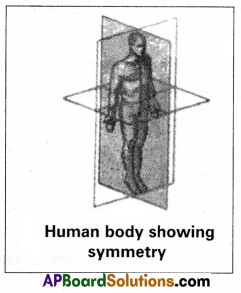
Asymmetry: The animals, which cannot be cut into two equal parts (antimeres) in any plane passing through the centre of the body is called asymmetrical, e.g.: most sponges and adult gastropods. In asymmetrical animals, the body lacks a definite form.
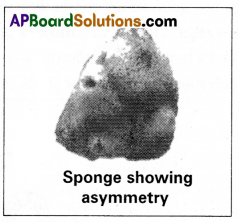
Symmetry: The regular arrangement of body parts in a geometrical design relative to the axis of the body is called symmetry. In a symmetrical animal, paired body parts are arranged on either side of the plane passing through the principal axis, such that they are equidistant from the plane. The unpaired body parts are located mostly on the plane, passing through the principal axis.
Basically, the symmetry in animals is of two kinds:
(i) Radial symmetry
(ii) Bilateral symmetry
(i) Radial Symmetry or Monaxial heteropolar Symmetry: When any plane passing through the central axis (oro-aboral axis/principal axis) of the body divides an organism into two identical parts, it is called radial symmetry. The animals with radial symmetry are either sessile or planktonic or sluggish forms. It is the principal symmetry of the diploblastic animals such as the cnidarians and ctenophores symmetrical (as it is five-angled, it is also called pentamerous radial symmetry). Radially symmetrical animals have many planes of symmetry, whereas pentamerous radially symmetrical animals have five planes of symmetry.

(ii) Bilateral symmetry: When only one plane (median sagittal plane) that passes through the central axis (anterior-posterior axis) divides an organism into two identical parts, it is called bilateral symmetry. It is the ‘principal type of symmetry’ in triploblastic animals. Among the triploblastic animals, some gastropods become secondarily asymmetrical though they have primarily bilaterally symmetrical larvae.

Bilaterally symmetrical animals are more efficient than other animals in seeking food, locating mates, and in avoiding or escaping from predators, because of cephalization (concentration of nerve and sensory cells at the anterior end). As a result of cephalization, bilaterally symmetrical animals can sense the new environment into which they enter and respond more efficiently and quickly.
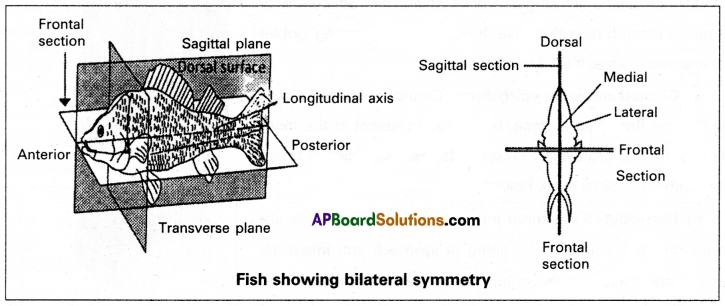
Question 3.
Classify and describe the epithelial tissues on the basis of structural modification of cells with examples.
Answer:
Epithelium (epi-upon; thelia – growing) forms the outer covering of the body and the living of internal organs and cavities. There are two types of epithelial tissues namely ‘simple epithelia1 and ‘compound epithelia’ based on the number of layers or strata.
Simple epithelium is composed of a single layer of cells and forms the lining of body cavities, ducts, and vessels. It helps in the diffusion, absorption, filtration, and secretion of substances. On the basis of the shape of the cells, it is further divided into three types:
(i) Simple squamous epithelium (Pavement epithelium): It is composed of a single layer of flat and tile-like cells, each with a centrally located ‘ovoid nucleus’. It is found in the endothelium of blood vessels, mesothelium of body cavities (pleura, peritoneum, and pericardium), wall of Bowman’s capsule of the nephron, lining of alveoli of lungs, etc.

(ii) Simple cuboidal epithelium: It is composed of a single layer of cube-like cells with centrally located spherical nuclei. It is found in germinal epi – thelium, proximal, and distal convoluted tubules of the nephron. Cuboidal epithelium of proximal convoluted tubule of nephron has ‘microvilli’.

(iii) Simple columnar epithelium: It is composed of a single layer of tall and slender cells with oval nuclei located near the base. It has mucus-secreting ‘goblet cells’ in some places. It is of two types:
(a) Ciliated columnar epithelium: Columnar epithelial cells have cilia on their free surface. It is mainly present in the inner surface of hollow organs like fallopian tubes, ventricles of the brain, the central canal of the spinal cord, bronchioles, etc.

(b) Non-ciliated columnar epithelium: Columnar cells are without cilia. It is found in the lining of the stomach and intestine. Microvilli are present in the columnar epithelium of the intestine to increase the surface area of absorption.

(II) Compound epithelium (stratified epithelium): It is made up of more than one layer of cells. Its main function is to provide protection against chemical and mechanical stress. It covers the dry surface of the skin as stratified, keratinized, squamous epithelium. It covers the moist surface of the buccal cavity, pharynx, esophagus, and vagina as stratified non-keratinized squamous epithelium. It forms the inner lining of the larger ducts of salivary glands, sweat glands, and pancreatic ducts as stratified cuboidal epithelium. It forms the wall of the urinary bladder as transitional epithelium.

(III) Glandular epithelium: Some of the columnar or cuboidal cells that get specialised for the production of certain secretions, form glandular epithelium. The glands are of two types – unicellular glands consisting of isolated glandular cells such as goblet cells of the gut, and multicellular glands, consisting of clusters of cells such as salivary glands. On the basis of the mode of pouring of their secretions, glands are divided into two types namely exocrine and endocrine glands. Exocrine glands are provided with ducts; that secrete mucus, saliva, earwax (cerumen), oil, milk, digestive enzymes, and other cell products. In contrast, endocrine glands are ductless and their products are ‘hormones’, which are not sent out via ducts, but are carried to the target organs by blood.
Based on the mode of secretion, exocrine glands are further divided into
(i) merocrine glands (e.g.: pancreas) which release the secretory granules without the loss of other cellular material.

(ii) Apocrine glands (e.g.: mammary glands) in which the apical part of the cell is pinched off along with the secretory product and
(iii) Holocrine glands (e.g.: sebaceous glands), in which the entire cell disintegrates to discharge the contents.
![]()
Question 4.
Describe the various types of connective tissue properly with suitable examples.
Answer:
Connective tissue proper is of two types as
(A) Loose connective tissue proper
(B) Dense connective tissue proper
(A) Loose connective tissue: Cells and fibres are loosely arranged in a semi-fluid ground substance there are three types of loose connective tissues-areolar tissue adipose tissue and reticular tissue.
(i) Areolar tissue: It is one of the most widely distributed connective tissues in the body. It forms the packing tissue in almost all organs. Areolar tissue forms the subcutaneous layer of the skin. It has cells and fibres. Cells of the areolar tissue are the fibroblasts, mast cells, macrophages, adipocytes, and plasma cells.
1. Fibroblasts are the most common cells with secreted fibres. The inactive cells are called
fibrocytes.
2. Mast cells secrete heparin (an anticoagulant), histamine, bradykinin (vasodilators), and serotonin (vasoconstrictor), vasodilators cause inflammation in response to injury and infection.
3. Macrophages are amoeboid cells, phagocytic in function, and act as internal scavengers. They are derived from the monocytes of blood. ‘Tissue fixed macrophages’ are called histiocytes and others are ‘wandering macrophages’.
4. Plasma cells are derived from the B-lymphocytes and produce antibodies.
5. Adipocytes are specialized cells for the storage of fats.

(ii) Adipose tissue: It is specialized for fat storage. It consists of a large number of adipocytes and few fibres. The adipose tissue which is found beneath the skin provides. Adipose tissue is of two types: white adipose tissue, and brown adipose tissue. Excess nutrients which are not used immediately are converted into fats and stored in this tissue.
White adipose tissue (WAT): It is the predominant type in adults, and the adipocyte has a single large lipid droplet (monocular). White fat is metabolically not active.
Brown adipose tissue (BAT): It is found in fetuses and infants. Adipocyte of BAT has several small ‘lipid droplets’ (multilocular) and numerous mitochondria. Brown fat is metabolically active and generates ‘heat’ to maintain the body temperature required by infants.
(iii) Reticular tissue: It has specialized fibroblasts called reticular cells. They secrete ‘reticular fibers’ that form an interconnecting network. It forms the ‘supporting framework’ of lymphoid organs such as bone marrow, spleen, and lymph nodes and forms the reticular lamina of the ‘basement membrane’.
(B) Dense connective tissue: This tissue consists of more fibres, but fewer cells. It has very little ground substance. Based on the arrangement of fibres, the dense connective tissue is of three types.
(i) Dense regular connective tissue: In this tissue, collagen fibres are arranged parallel to one another in bundles. Tendons that attach the skeletal muscles to bones and ligaments which attach bones to other bones are examples of this type of connective tissue.

(ii) Dense irregular connective tissue: In this type of connective tissue, bundles of collagen fibres are irregularly arranged. Periosteum, endosteum, pericardium, heart valves, joint capsule, and deeper region of the dermis of skin contain/are made up of this type of connective tissue.

(iii) Elastic connective tissue: It is mainly made of yellow elastic fibres, capable of considerable extension and recoil. This tissue can recoil to its original shape, when the forces of stretch are released. It occurs in the wall of arteries, vocal cords, trachea, bronchi, and ‘elastic ligaments’ present between vertebrae.
In addition to the above-mentioned connective tissues, mucous connective tissue occurs as foetal or embryonic connective tissue. It is present in the umbilical cord as Wharton’s jelly.
Question 5.
What is skeletal tissue? Describe the various types of skeletal tissue.
Answer:
Skeletal tissue (supporting tissue): It forms the endoskeleton of the vertebrates. It supports the body, protects various organs, provides a surface for the attachment of muscles, and helps in locomotion. It is of two types:
(A) Cartilage (Gristle): Cartilage is a solid, but semi-rigid (flexible) connective tissue. It resists compression. Matrix is firm but somewhat pliable. It has collagen fibres, elastic fibres (only in the elastic cartilage), and matrix-secreting cells called chondroblasts. These cells are enclosed in fluid-filled spaces called lacunae. Chondrocytes are the inactive cells of cartilage. Cartilage is surrounded by a fibrous connective tissue sheath called perichondrium.
Cartilage is of three types, which differ from each other chiefly in the composition of the matrix.
1. Hyaline cartilage: It is bluish-white, translucent, and glass-like cartilage. Matrix is homogeneous and shows delicate collagen fibres. It is the weakest and the most common type of cartilage. It is found in the walls of the nose, Larynx, trachea, and bronchi.
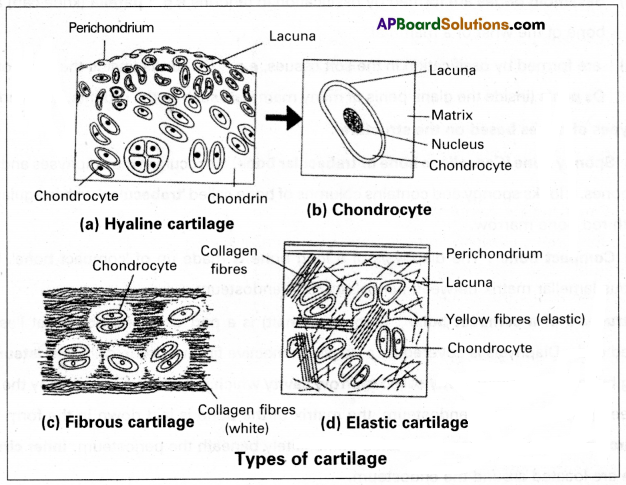
2. Elastic cartilage: It is yellowish due to elastic fibres. Matrix has an abundance of yellow elastic fibres in addition to collagen fibres. It provides strength and elasticity. Perichondrium is present. It is found in the pinnae of the external ears, Eustachian tubes, and epiglottis.
3. Fibrous cartilage: Matrix has bundles of collagen fibres. The perichondrium is absent. It is the strongest of all types of cartilage. It occurs in the intervertebral discs and pubic symphysis of the pelvis.
(B) Bone (osseous) tissue: Bone is highly calcified (mineralized), solid, hard and rigid connective tissue. It is the major component of the endoskeleton of most adult vertebrates.
Bone has an outer fibrous connective tissue sheath called periosteum, the inner connective tissue sheath that lines the marrow cavity called the endosteum, a non-living extracellular matrix, living cells, and bone marrow. Bone cells include osteoblasts, osteocytes, and osteoclasts. Osteoblasts (immature bone cells) secrete the organic components (collagen fibres) of the matrix and also play an important role in the ‘mineralization of bone’ and become osteocytes (mature bone cells). Osteocytes are enclosed in fluid-filled lacunae. Osteoclasts are phagocytic cells involved in the resorption of bone.
Types of bones based on the method of formation:
(i) Cartilage bones (replacing bones or endochondral bones) are formed by ossification within the cartilage e.g. bones of limbs, girdles, and vertebrae.
(ii) Investing bones (membrane bones or dermal bones) are formed by the ossification in the embryonic mesenchyme e.g. most of the bones of the cranium.
(iii) Sesamoid bones are formed by ossification in tendons e.g.: patella (knee cap) and pisiform bone of the wrist of a mammal
(iv) are formed by ossification in the soft tissues, e.g.: Oscordis (inside the heart of ruminants), and Ospenis (inside the glans-penis of many mammals such as rodents, bats, and carnivores).
Types of bones based on the structure:
1. Spongy bone (Cancellous bone or trabecular bone): It occurs in the epiphyses and metaphyses
of long bones. It looks spongy and contains columns of bone called ‘trabeculae’ with irregular interspaces filled with red bone marrow.
2. Compact bone: The diaphysis of a long bone is made up of ‘compact bone. It has a dense continuous lamellar matrix between the periosteum and endosteum.
Structure of a compact bone: Diaphysis (shaft) is a part of a long bone that lies in between expanded ends. The diaphysis is covered by a dense connective fibrous tissue called the periosteum. The diaphysis of a long bone has a hollow cavity called marrow cavity which is lined or surrounded by the endosteum. In between periosteum and endosteum, the matrix of the bone is laid down in the form of ‘lamellae’. Outer circumferential lamellae are located immediately beneath the periosteum; inner circumferential lamellae are located around the endosteum.

Between the outer and inner circumferential lamellae, there are many Haversian systems (osteons – units of bone). The spaces between the Haversian systems are filled with interstitial lamellae. Haversian system consists of a Haversian canal that runs parallel to the marrow cavity. It contains an artery, a vein and a lymphatic vessel. Haversian canal is surrounded by concentric lamellae. Small fluid filled spaces called ‘lacunae’ provided with minute canaliculi lie in between the lamellae.
Canaliculi connect the lacunae with one another and with Haversian canal. Each lacuna encloses one osteocyte (inactive form of osteoblast). The cytoplasmic processes of osteocytes extend through canaliculi. A Haversian canal and the surrounding lamellae and lacunae are collectively called a Haversian system or osteon. The Haversian canals communicate with one another, with the periosteum and also with the marrow cavity by transverse or oblique canals called Volkmanns canals. Nutrients and gases diffuse from the vascular supply of Haversian canals.
![]()
Question 6.
Give an account of the “formed elements” of Blood.
Answer:
Blood is a red-coloured, opaque, and slightly alkaline fluid. It is composed of blood plasma and formed elements or blood cells – the RBC, WBC, and platelets.
Formed elements of Blood cells: The blood corpuscles (RBC and WBC) constitute 45% of the total blood by volume.
(i) Red blood corpuscles (Erythrocytes): Erythrocytes of mammals are circular (elliptical in camels and Liamas), biconcave and enucleate. The biconcave shape provides a large surface area-to-volume ratio, thus providing more area for the exchange of gases. These are 7.8 pm in diameter. The number of RBCs per cubic millimeter of blood is about 5 million in a man and 4.5 million in a woman.
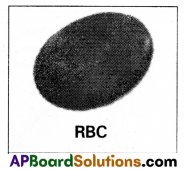
(ii) White blood corpuscles (Leucocytes): These are nucleate, colourless, complete cells. They are spherical or irregular in shape and are capable of exhibiting amoeboid movement into the extravascular areas by diapedesis. WBC are two main types: 1) Granulocytes and 2) Agranulocytes.
Granulocytes: They possess cytoplasmic granules that may take three different types of stains, neutral or acidic, or basic. The nucleus of the granulocytes is divided into lobes and assumes different shapes, hence, these are also called polymorphonuclear leucocytes. Based on the staining properties these are of three tvoes.

Basophils: They constitute about 0.4% of the total leucocytes. The nucleus is divided into irregular lobes. Cytoplasmic granules are ‘fewer’ and ‘irregular’ in shape. They take basic stains. They produce heparin, histamine, etc. They supplement the function of mast cells when needed.
Eosinophils (acidophils): They constitute about 2.3% of the total leucocytes. The nucleus is distinctly bilobed. The cytoplasm has large granules which stain with acidic dyes such as ‘eosin’.
Neutrophils: They constitute about 62% of the total leucocytes. The nucleus is many lobed (2-5). Specific cytoplasmic granules are small and abundant. They stain with ‘neutral dyes’.
Agranulocytes: Cytoplasmic granules are absent in agranulocytes. divided into lobes. These are of two types:
(a) Lymphocytes: They constitute about 30% of the total leucocytes. They are small, spherical cells with large spherical nuclei and scanty peripheral cytoplasm. There are functionally two types of lymphocytes – ‘B’ lymphocytes, which produce ‘antibodies’ and T lymphocytes which play a key role in the immunological reactions of the body. Some lymphocytes live only a few days while others survive for many years.

(b) Monocytes: They constitute about 5.3% of the leucocytes. The nucleus is kidney-shaped (reniform). These are the largest, motile phagocytes. They engulf bacteria and cellular debris. They differentiate into macrophages when they enter the connective tissues.

(iii) Blood platelets (Thrombocytes): These are colourless non-nucleated, round, or oval biconvex discs. The number of platelets per cubic mm of blood is about 2,50,000-4,50,000. They are formed from giant megakaryocytes produced in the red bone marrow by fragmentation. The average lifespan of blood platelets is about 5 to 9 days. They secrete thromboplastin and play an important role in blood clotting. They adhere to the damaged endothelial lining of capillaries and seal minor vascular openings.
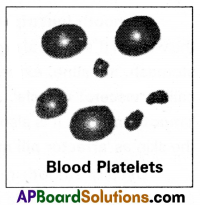
Question 7.
Compare and contrast the three types of muscular tissues.
Answer:
Muscular tissue is mesodermal in origin. Muscles show three essential properties such as excitability, conductivity, and contractility. The study of muscular tissues is known as mycology. Muscular tissue has elongated cells called ‘muscle fibers’ (myocytes) which are surrounded by a connective tissue sheath. The extracellular matrix is absent. The plasma membrane of a muscle fiber is called sarcolemma.
The cytoplasm of a muscle fibre is called Sarco plasm, the endoplasmic reticulum, the sarcoplasmic reticulum, and the mitochondria, the Sarcosomes. The cytoplasm of a muscle fibre has several myofibrils. Each myofibril has thick (myosin) and thin (actin) myofilaments. The regular arrangement of myosin and actin filaments is responsible for the alternate dark and light bands of a ‘striated muscle’. Sarcoplasm also contains ATP, phosphocreatine, glycogen, and myoglobin. Muscles are of three types – skeletal, smooth, and cardiac.
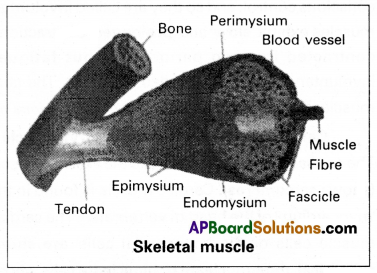
Skeletal (striped and voluntary) muscle: It is usually attached to skeletal structures by ‘tendons’. A typical muscle such as the ‘biceps’ muscle/skeletal muscle fibre is surrounded by a thin connective tissue sheath, the endomysium. A bundle of muscle fibres is called a fascicle.
It is surrounded by a connective tissue sheath called perimysium. A group of fascicles forms a ‘muscle’ that is surrounded by an epimysium (outermost connective tissue sheath). These connective tissue layers may extend beyond the muscle to form a chord-like tendon or sheet¬like aponeurosis.
A skeletal muscle fibre is a long, cylindrical, and unbranched cell. It is a multinucleated cell with many oval nuclei characteristically in the “peripheral” cytoplasm (a syncytium formed by the fusion of cells). Sarcoplasm has many myofibrils which show alternate dark and light bands. So it is called striped or striated muscle.
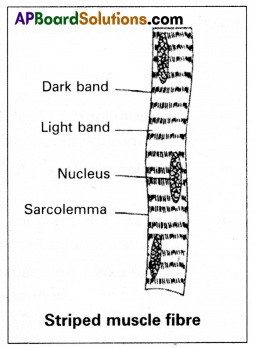
Smooth (unstriped and involuntary muscle): It is located in the walls of the visceral organs such as blood vessels, trachea, bronchi, stomach, intestine, excretory and genital ducts, and so this is also called ‘visceral muscle’. As cross striations are absent, it is called ‘smooth muscle. It is also found in the iris and ciliary body of the eye and in the skin as ‘arrector pili muscles that are attached to hair follicles.

Usually, smooth muscles are arranged in ‘layers’/’sheets’. A smooth muscle fibre is a spindle-shaped (fusiform), uninucleate cell. Myofibrils do not show alternate dark and light bands due to the irregular arrangement of actin and myosin fibres. They do not work under conscious control, and so they are called involuntary muscles. Smooth muscles exhibit ‘slow’ and ‘prolonged’ contractions. They may remain contracted for long periods without fatigue (show sustained involuntary contractions called ‘spasms’). The contraction of smooth muscles is under the control of the autonomous nervous system.
![]()
Cardiac (striped and involuntary) muscle: The cardiac muscle is striated like the skeletal muscle (shows sarcomeres). Cardiac muscle is found in the ‘myocardium’ of the heart of vertebrates. The cardiac muscle cells or the ‘myocardial cells’ are short, cylindrical, mononucleate, or binucleate cells whose ends branch and form junctions with other cardiac muscle cells. Each myocardial cell is joined to adjacent myocardial cells by ‘electrical synapses’ or gap junctions. They permit ‘electrical impulses’ to be conducted along the long axis of the cardiac muscle fibre. The dark lines across cardiac muscle are called intercalated discs (IDs). These discs are highly characteristic of the cardiac muscle.
